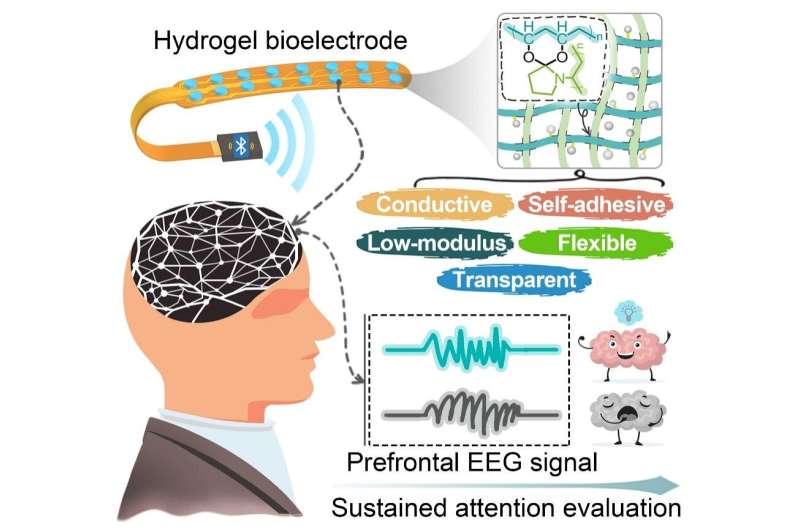This article has been reviewed according to Science X's editorial process and policies. Editors have highlighted the following attributes while ensuring the content's credibility:
fact-checked
peer-reviewed publication
trusted source
proofread
Multifunctional hydrogel electrode helps to collect high-quality electroencephalography signals

Researchers from the Institute of Process Engineering (IPE) of the Chinese Academy of Sciences and Tsinghua University have developed a multifunctional hydrogel electrode with excellent conductivity, adhesion, and anti-interference properties, which can achieve high-quality wireless collection of prefrontal electroencephalography (EEG) signals.
The study was published in Advanced Materials on Jan. 9.
High-quality EEG signals can be used for diagnosing and treating of brain-related diseases, as well as evaluating sustained attention levels.
However, the existing EEG collection devices, with high power noise and poor anti-interference capability, are bulky and complex, and they can be easily interfered with the movement of the subjects, causing difficulty in collecting high-quality EEG signals.
Moreover, the essential differences in electrical and mechanical characteristics between human tissue and sensing electrodes can lead to signal distortion. The hydrogel currently used in collection devices cannot resist interference factors such as sweat and motion artifacts, unsatisfying the demand for efficient collection.
To solve the above issues, the research team used the nanoparticle-enhancement and homogenous network effect to develop a multifunctional hydrogel. "It has the properties of excellent conductivity, adhesion, flexibility, elasticity, and biocompatibility, which can bridge the difference between human tissue and electrodes, and provide an efficient and stable conduction channel for EEG signal collection," said Prof. Bai Shuo from IPE.
A free-radical oxidation degradation strategy was applied to prepare polydopamine nanoparticles that mimic the adhesive properties of mussels. During the process, the free radicals disrupted the π-stacking in polydopamine aggregates and promoted the conversion of indole units to pyrrole acid units, providing a stronger ion conductivity and tissue adhesion performance for the gel system. In addition, by controlling the cross-linking density, both low-stretch elasticity and high elasticity can be achieved.
According to experiment data, sensing electrodes based on this hydrogel showed an excellent performance in terms of contact impedance and noise power, as well as long-term stability and good resistance to common interference factors such as sweat and motion artifacts.
To further explore prediction accuracy, the researchers conducted a five-fold cross-validation experiment on EEG data from 24 volunteer subjects, with an accuracy of up to 91.5%.
More information: Qingquan Han et al, Hydrogel Nanoarchitectonics of a Flexible and Self‐Adhesive Electrode for Long‐Term Wireless Electroencephalogram Recording and High‐Accuracy Sustained Attention Evaluation, Advanced Materials (2023). DOI: 10.1002/adma.202209606
Journal information: Advanced Materials
Provided by Chinese Academy of Sciences





















